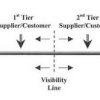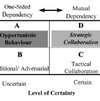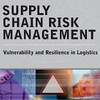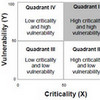 Göran Svensson is one of the leading key figures in supply chain vulnerability research and his concepts and models of supply chain vulnerability are usually well thought-out and easy to understand. So is Key areas, causes and contingency planning of corporate vulnerability in supply chains: A qualitative approach. Here Svensson builds the construct of supply chain vulnerability around three components: time dependence, functional dependence and relational dependence.
Göran Svensson is one of the leading key figures in supply chain vulnerability research and his concepts and models of supply chain vulnerability are usually well thought-out and easy to understand. So is Key areas, causes and contingency planning of corporate vulnerability in supply chains: A qualitative approach. Here Svensson builds the construct of supply chain vulnerability around three components: time dependence, functional dependence and relational dependence.
Qualitative, not quantitative
In this study, Svensson investigates the areas, the causes and the contingency planning of corporate vulnerability in upstream and downstream supply chains. What sets this study apart from many other studies in supply chain vulnerability is that it is based on qualitative data, while most other studies on the vulnerability construct in supply chains have been quantitative. Being a qualitative rather than a qualitative researcher myself I can only applaud such an approach.
Three dependencies: time – function – relation
Svensson constructs corporate vulnerability using three components, namely time dependence, functional dependence and relational dependence in the upstream and downstream supply chain. Time and functional dependencies refer to the fact that there is a chronological or sequential dependence in supply chains, and relational dependence refers to other relationship-specific factors that influence the interaction in supply chains.
Corporate vulnerability is a condition that is caused by time, functional and relational dependencies in a supply chain. The degree of corporate vulnerability may be interpreted as proportional to the degree of time, functional and relational dependencies, and the negative consequence of these dependencies, in a supply chain.
Consequently, the awareness of the key areas of supply chain vulnerability, together with the appropriate contingency planning for these vulnerabilities, should be of utmost importance to any company. Ericsson’s unfortunate handling of the Albuquerque fire in 2000 is one of the prime examples of what happens if this is not taken care of.
Statements about Supply Chain Management
One interesting feature of Svensson’s article is a collection of ‘Statements about Supply Chain Management’, taken from the literature (click to enlarge):
The reason for Svensson to include these statements is obvious: Most statements regard Supply Chain Management as a management philosophy that strives to integrate the vertically dependent activities, actors, and resources between the point-of-origin and the point-of-final-consumption. Nonetheless, SCM should also have a horizontal emphasis, says Svensson. This means that SCM ought to comprise different kinds of dependencies in, between and across companies, in and between supply chains.
The framework
Using his previous research, see links below, Svensson sets up the following framework for his supply chain model:
- Internal flows
- a company’s internal business activities between inbound and outbound logistics flows
- External flows
- a company’s external inbound and outbound business activities in the supply chains, that is the upstream and downstream business activities
- Atomistic perspective
- a company’s business activities between the 1st tier suppliers and the 1st tier customers in the supply chain
- Holistic perspective
- a company’s business activities beyond the 1st tier suppliers and beyond the 1st tier customers in the supply chain
- Time dependence
- time plans, delays, lead times, delivery schedules and prognoses in the companies’ upstream and downstream supply chains.
- Functional dependence
- corporate functions, such as the upstream and downstream inventories, production, products, transports, third party logistics, maintenance, capacity and preventive activities, certifications, and any other qualitative and quantitative assurances of companies’ business activities
- Relational dependence
- economics, legal aspects, technology, knowledge, social aspects, the market, IT, HR, information, communication, variability and planning, suppliers and customers
What is interesting here is how Svensson’s previous research is seamlessly woven into the current and new ideas.
The study
In his empirical study, Svensson then asks
- What are the key areas of corporate vulnerability in thecompany’s upstream/downstream supply chains?
- What are the causes of corporate vulnerability in the company’s upstream/downstream supply chains?
- What kind of CP for corporate vulnerability does the company perform in the upstream/downstream supply chains?
and answers the questions in relates it to the above framework of time, function and relation dependencies.
The findings
Svensson concludes that
two generic determinants influence the perception of corporate vulnerability in the upstream and downstream supply chains, namely the degree of transparency and the degree of obscurity
The degree of transparency increases as the accuracy of the information in the supply chain improves, while the degree of obscurity increases as the accuracy of the information in the supply chain deteriorates. What he means by that is that an holistic view of the supply chain leads to transparency, while a more atomistic view leads to obscurity, as seen from the focal firm’s perspective. Thus, there is a ‘visibility line’ that must be pushed from transparency into obscurity (my pun; intended):
Svensson’s empirical findings suggest a
prevalence of a myopic view of corporate vulnerability in the companies’ upstream and downstream supply chains […] the view is vertical, and ignores horizontal considerations
Apparently, here lies one of the core challenges of how to address supply chain vulnerability. It’s not just about my supply chain and my company. Supply chain vulnerability is about the wider business environment:
Corporate vulnerability may be influenced by the current and potential direct and indirect dependencies, the vertical and horizontal dependencies, as well as the unidirectional and bi-directional dependencies, between business activities in and between supply chains. […] Therefore, the companies’ strategic agenda has to be dedicated to the internal strengths and weaknesses, as well as to the external opportunities and the threats, in current supply chains.
My verdict
A very fine paper. Definitely qualitative, but nonetheless of great value. Particularly since Svensson’s models are simple, yet complicated and all-encompassing at the same time.
Reference
Svensson, G. (2004). Key areas, causes and contingency planning of corporate vulnerability in supply chains: A qualitative approach International Journal of Physical Distribution & Logistics Management, 34 (9), 728-748 DOI: 10.1108/09600030410567496
Links
- Halmstad University: Göran Svensson‘s homepage
- nordinavia.se: Göran Svensson’s full professional profile and CV















